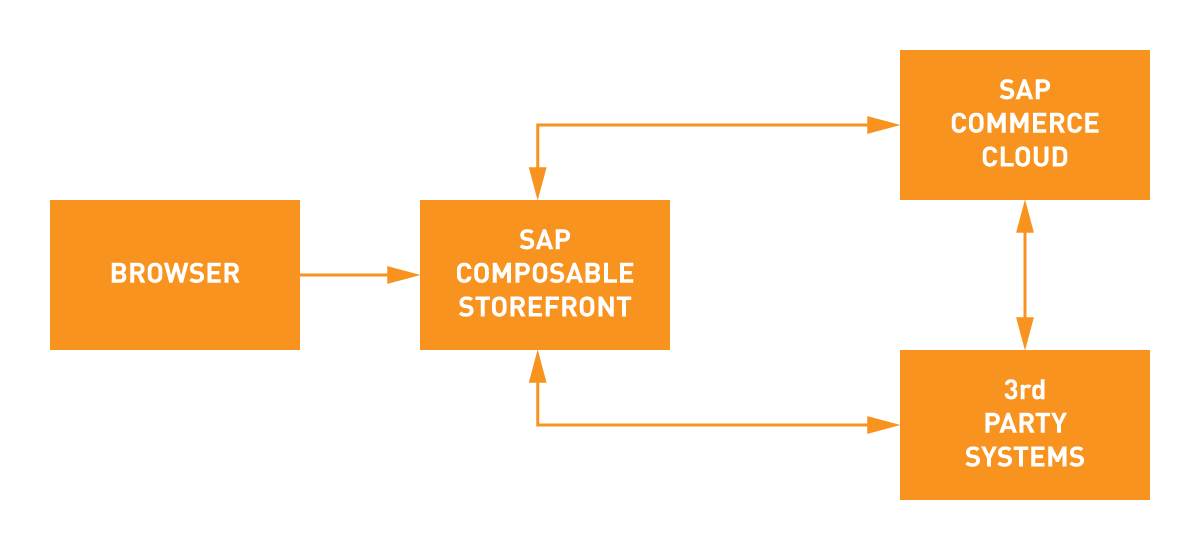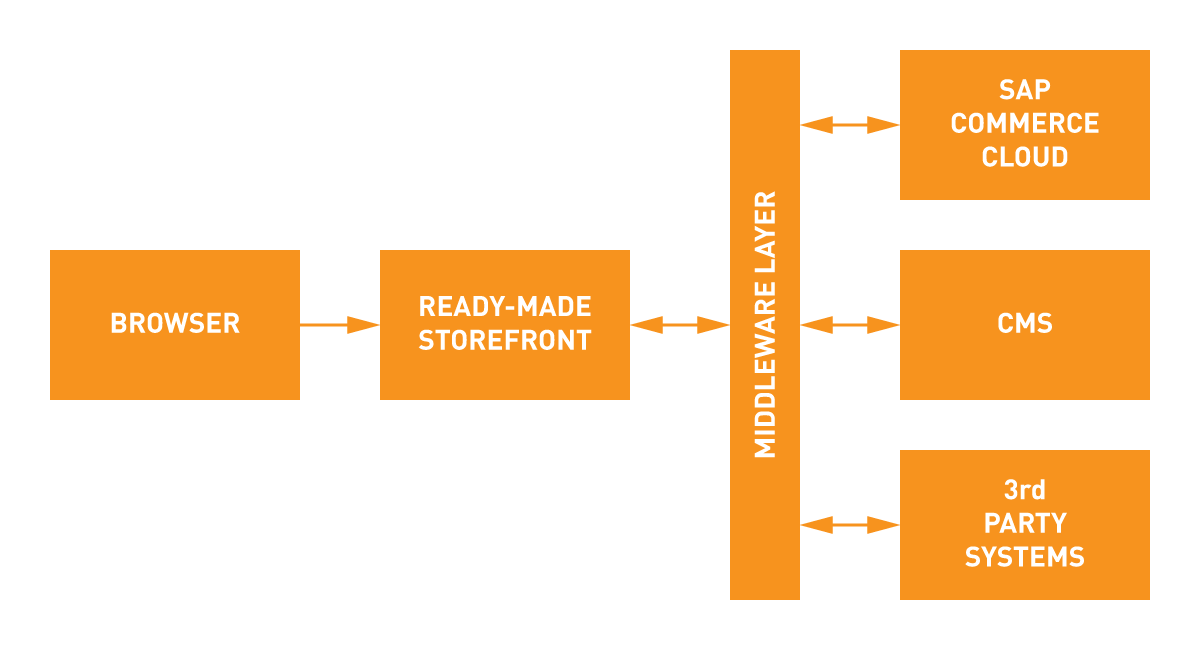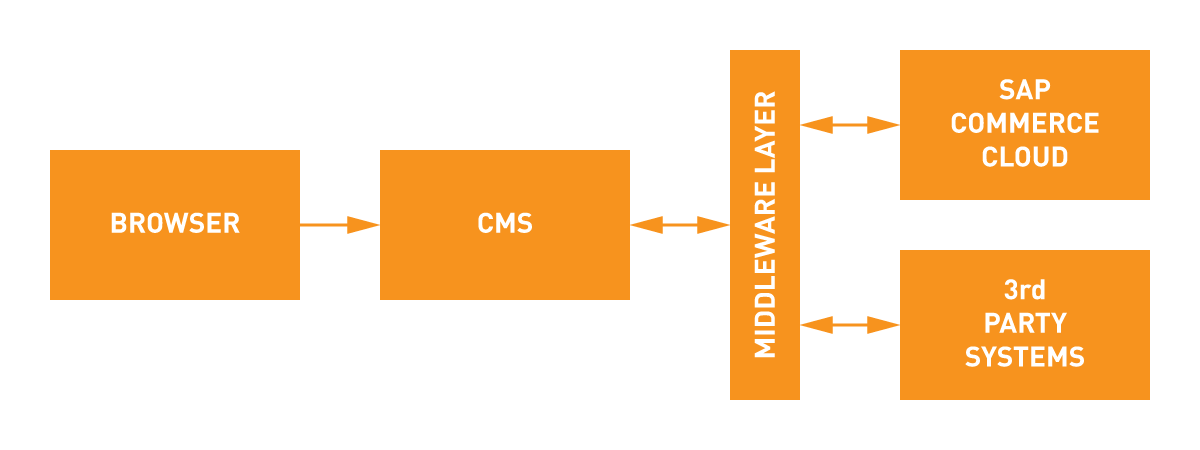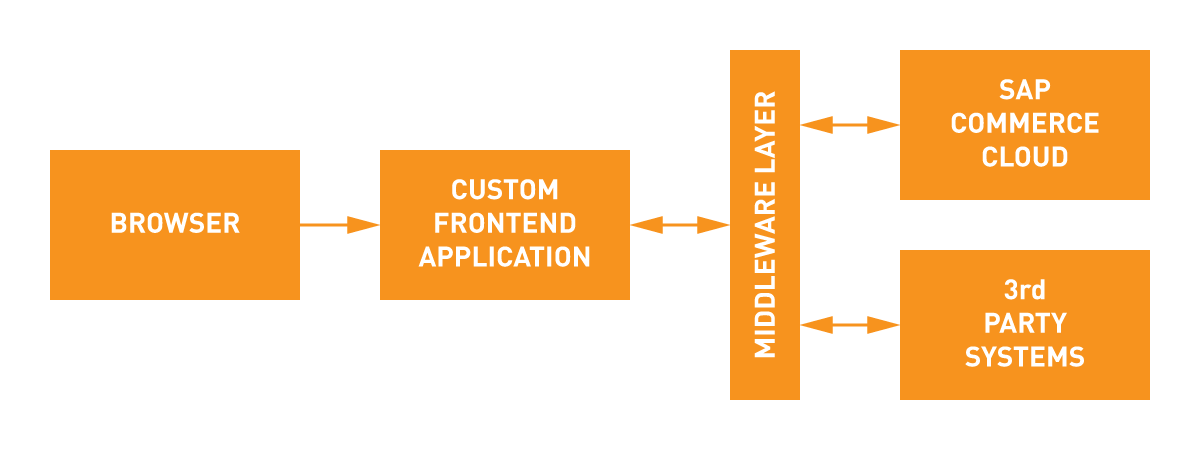
Post-Accelerator Frontend Strategies for New SAP Commerce Storefront
While the countdown to the end of SAP Commerce Accelerator support has begun, it is essential to start thinking about your next steps. Dive into the four frontend strategies that can keep your transition seamless.
E-commerce has come a long way from the monolithic setups that once dominated the industry. In traditional architectures, like the earlier versions of SAP Commerce, every component – backend and frontend – was tightly bound together. This meant that even the smallest change could require a full redeployment. The use of legacy technologies like JSP only amplified these limitations. But as customer expectations for personalization, new features and experiences skyrocketed, the rigidity of monolithic systems became an obstacle.
Enter headless commerce. By decoupling the backend from the frontend and bridging them through APIs, headless architecture offers a flexibility that meets modern needs. Backend teams can focus on core functionalities without needing to tailor everything for a specific frontend, making it easier to support multiple channels like mobile, web, and even IoT, with faster release cycles and fewer dependencies.
SAP recognized this shift and began moving its Commerce Cloud platform towards a more composable, API-driven model. This transformation now reaches a key juncture: as of Q2 2027, SAP will release its final update that includes the Accelerator UI components, marking the start of a new era where Accelerator-based storefronts will no longer receive support. Starting from Q3 2028, support will end entirely, leaving users with a choice: adapt or maintain the deprecated code on their own.
So, what options do current Accelerator users have?
With a range of new, adaptable frontend strategies on the horizon, there is no shortage of solutions to help them make a smooth transition.
As an SAP Gold Partner specializing in SAP Commerce, we recommend four key strategies for a successful transition:
- leveraging SAP’s Composable Storefront
- exploring other ready-made storefront solutions
- implementing a CMS centralized solution
- building a custom frontend tailored to specific business needs.
Option 1: SAP Composable Storefront
SAP Composable Storefront, formerly known as Spartacus, represents SAP’s modern alternative to the legacy Accelerator extensions and addons.
Choose this option if your team is still getting up to speed with modern frontend technologies and would benefit from a solution that is already developed and maintained by SAP, providing a ready-made framework with built-in best practices.

Modern Framework: Built on a contemporary JavaScript application framework, SAP Composable Storefront delivers a single-page application experience, allowing smooth transitions without page reloads. This approach mimics the responsiveness of a mobile app and greatly enhances the user experience.
Simplified Customizations: Unlike its monolithic predecessor, Composable Storefront minimizes the need for complex customizations, making it easier to implement, iterate, and maintain over time. Teams can focus more on customer-facing updates rather than backend dependencies.
CMS Integration: While a CMS is required, it plays a lighter role in managing the storefront. This setup enables teams to focus on dynamic content creation and branding, with less dependency on backend-heavy configurations.
Rapid Feature Updates: With a headless, API-driven structure, teams can independently update the frontend experience, speeding up the delivery of new features and optimizations. This flexibility allows teams to experiment with new user-facing features faster, supporting a more agile approach.
Omnichannel Ready: As customer engagement expands across platforms, SAP Composable Storefront is optimized for multi-channel strategies, allowing easy access to new channels like mobile, social commerce, and more.
Option 2: Ready-Made Storefront
Ready-made storefronts offer an out-of-the-box, pre-configured frontend solution designed to work seamlessly with backend systems, including SAP Commerce Cloud. This approach is ideal for businesses that want to transition to a modern frontend experience without extensive development or customization efforts.
Choose this option if your team wants a straightforward, modern frontend solution without the burden of extensive development and maintenance work. This option suits organizations looking for a flexible, future-proof approach to storefront management while keeping backend integration simple and manageable.

Quicker Start with Modern Frontend: Ready-made storefronts come prebuilt on contemporary frontend frameworks, making it easy for teams to adopt modern frontend practices without the complexities of building from scratch.
Backend for Frontend (BFF) as a Service: With BFF delivered as a Platform-as-a-Service (PaaS), the setup reduces the backend development work, handling key integrations while giving your team more flexibility to focus on frontend updates and user experience improvements.
Streamlined Maintenance: While there are typically higher licensing fees, ready-made storefronts reduce the ongoing maintenance and monitoring workload, as much of the infrastructure and backend integration is managed by the provider.
Prebuilt Integrations: Many ready-made storefront solutions come with prebuilt integrations for a wide range of platforms, including CMS, e-commerce, payment gateways, and Product Information Management (PIM) systems. This setup can significantly reduce the time and cost involved in connecting to essential systems and launching the storefront.
Ease of Technology Replacement: Thanks to their integration flexibility, ready-made storefronts simplify the process of swapping out backend components. Whether it is e-commerce platforms, payment providers, CMS solutions, or PIM systems, this architecture supports easy technology transitions if you decide to switch providers down the line.
Option 3: CMS as a centralized solution
The CMS upfront approach places the CMS as the central hub for managing both content and e-commerce pages. Here, all web pages — including product and transactional pages — are hosted within the CMS, which then retrieves e-commerce data directly or through a middleware layer. This setup can streamline content management and ensure consistency across your digital experience.
Choose this option if you have a reliable CMS solution in place that suits your needs, manage large volumes of content frequently, and run a more standardized e-commerce model without complex customization requirements. This option is ideal for businesses looking to streamline content management while keeping e-commerce capabilities straightforward.

Unified Content Management: With a CMS handling all pages, you gain a single, centralized platform for managing both e-commerce and content pages. This can simplify updates, particularly if your site is content-heavy and requires frequent modifications.
Direct or Middleware Integration: This setup can directly connect to your e-commerce solution, ensuring smooth and real-time data flow for things like product details, pricing, and inventory. Alternatively, a middleware layer can be used to mediate connections, offering an additional layer of customization and control over data handling.
Optimized for Standard E-Commerce Features: This approach is ideal for e-commerce setups that rely on widely used, straightforward features without extensive customization or unique self-service capabilities. It is a practical solution for businesses whose needs align with standard e-commerce functionality, without the demand for highly tailored content layouts or complex user interface flows.
Cost-Efficient Solution: By managing most of the frontend through a CMS, you can reduce development costs, as well as maintenance associated with complex e-commerce-specific frontends. If your team is already proficient with your current CMS, this option allows you to leverage that existing expertise.
Option 4: Custom Frontend (Greenfield)
Building a custom solution from scratch allows organizations to create a storefront tailored to their unique needs, rather than relying on the building blocks offered by software vendors.
Choose this option if your organization has specific, non-standard frontend needs, your team is skilled in a different tech stack, or you prefer not to be constrained by vendor strategies that may not align with your business vision.

Tailored Frontend Experience: This option is ideal for businesses whose frontend requirements significantly diverge from standard offerings. It enables the creation of a truly unique user interface and user experience that aligns perfectly with your brand and business goals.
Alignment with Team Expertise: If your development team has expertise in technologies that differ from the stacks proposed by vendors, a custom solution empowers them to leverage their skills fully. This choice minimizes the need for extensive retraining and allows the team to work more efficiently with familiar tools and technologies.
Independence from Vendor Strategies: A custom approach gives you the freedom to avoid aligning your business strategy with that of your e-commerce vendor. Vendors may adapt to trends that do not necessarily fit your vision, leading to additional costs and potential disruptions. This option allows you to develop a strategy that suits your budget and long-term objectives without the pressure of vendor timelines or updates.
What’s next?
As you navigate this transition, remember that there is no one-size-fits-all solution. Your company’s specific context plays a crucial role in determining the best approach.
Selecting an option is just the beginning; you will also need to consider the following next steps:
- Migration Strategy Plan: Develop a comprehensive strategy to ensure a smooth transition from your current setup to your chosen option.
- Timeline Estimation: Create realistic timelines for each phase of the transition to manage expectations and keep stakeholders informed.
- Communication Plan: Establish clear agreements with the business regarding timelines and the scope of changes to ensure everyone is aligned.
- Implementation: Execute the plan with diligence and adaptability, keeping a close eye on potential challenges and adjustments.
We have years of experience in developing and configuring e-commerce systems for leading European companies. They all prefer a flexible e-commerce solution for the reasons already mentioned. However, their requirements and conditions vary widely.
Are you also interested in a new solution? Write to us at experts@striped-giraffe.com and let’s get started.

